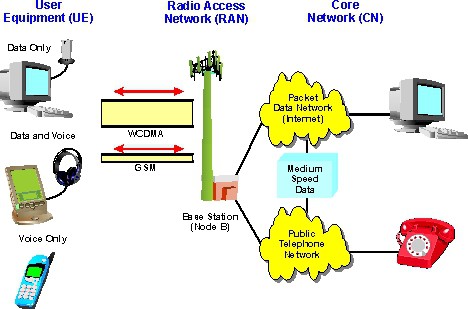Definition of Wideband Code Division Multiple Access (W-CDMA) in The Network Encyclopedia.
What is W-CDMA(Wideband Code Division Multiple Access)?
Wideband Code Division Multiple Access, or W-CDMA, is a wireless communication technology derived from Code Division Multiple Access (CDMA) cellular phone technology that is proposed for 3G (third-generation) wireless communication systems.

Wideband Code Division Multiple Access (W-CDMA) uses wider frequency bands than CDMA, so it can achieve higher throughput for data transmission. The Universal Mobile Telecommunications System (UMTS) standard proposed by the European Telecommunications Standards Institute (ETSI) and incorporated into the International Mobile Telecommunications-2000 (IMT-2000)initiative of the International Telecommunication Union (ITU) is partly based on W-CDMA.
W-CDMA is not fully compatible with air and network interfaces of the proposed CDMA2000 standard, which is another part of the IMT-2000 initiative, and it is not compatible with the air interface of the existing Global System for Mobile Communications (GSM) cellular phone network. The CDMA2000 standard uses synchronous base station transmissions with 20-millisecond frames, while W-CDMA uses asynchronous base station transmissions with 10-millisecond frames.
Wideband Code Division Multiple Access, IEEE Journal
To satisfy ever-increasing demands for higher data rates, as well as to allow more users to simultaneously access the network, interest has peaked in what has come to be known as wideband code division multiple access (WCDMA). In this paper, we discuss those basic characteristics of WCDMA waveforms that make them attractive for high data rate transmission over wireless and mobile channels. We emphasize how the choice of spread bandwidth affects the bit error rate of the system, as well as how it affects the reliability of various subsystems, such as those that perform coarse acquisition and adaptive power control. We then discuss how some of the waveforms being considered for cellular WCDMA systems differ from those in use in the narrowband CDMA cellular system, and emphasize, as an example, multicarrier CDMA.
Finally, we discuss other potential enhancements to WCDMA systems, such as the use of interference suppression at the receiver, or multiple antennas at the transmitter.